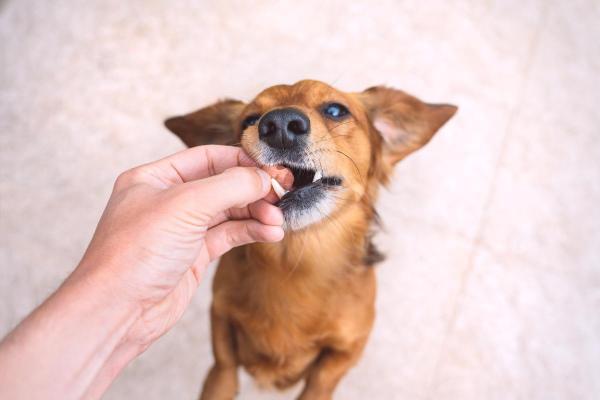Why My Dog Only Eats From My Hands?



See files for Dogs
For many dog owners, the act of mealtime is often as straightforward as filling a bowl and witnessing their dog joyfully consume its contents. However, for some, this routine takes an intriguing twist. Despite being otherwise enthusiastic eaters, their dogs flatly reject their food unless it's presented directly from their hand. This preference for hand-fed meals, although appearing uncommon, transcends various breeds and age groups.
Unraveling the motives behind this behavior extends beyond mere convenience; it becomes a pivotal stride towards safeguarding your dog's holistic well-being. This is why this AnimalWised article explores five causes behind why your dog only eats form your hand.
Learned behavior
The reason why a dog may develop a preference for being hand-fed is often linked to unintentional training or reinforcement of behaviors during puppyhood.
Hand-feeding unintentionally activates operant conditioning, where your dog associates eating from your hand with a positive outcome (attention, stress relief, control). They learn to repeat the behavior (eating from your hand) to receive the desired reward.
Even mild forms of attention like talking, petting, or simply looking at your dog while they eat from your hand can be rewarding for them, especially if they haven't learned to enjoy self-feeding yet.
Actions like hand-feeding, even with good intentions such as building trust or aiding in transitions, can inadvertently lead to habits that may not be suitable in adulthood.
What to do:
To address this, it's recommended to establish a regular meal schedule to create a feeding routine and prevent potential anxiety or undesirable behaviors related to food.
Slowly phase out hand-feeding by gradually decreasing the amount of food offered by hand and increasing the amount placed in their bowl.
Reward them for approaching and eating from their bowl independently. Celebrate even small victories! Use treats, praise, and affection to reinforce positive behaviors like starting to eat from their bowl on their own.
If your dog's behavior is causing significant stress or difficulty, consider consulting a veterinary behaviorist or trainer for personalized guidance and training techniques.
You might be interested in this other article, where we explore what classical conditioning in dogs is.

Comfort and security
Dogs have a knack for capturing our attention, especially when they seek something or crave companionship. They employ various attention-grabbing behaviors, persisting until they achieve their goal. These behaviors range from incessant barking, energetic jumping, and frenzied running to toppling their food bowl or refusing to eat unless you're present – all strategies aimed at diverting your focus.
Moreover, if a dog experiences hand-feeding during the critical socialization and development period (between 3-12 weeks), they may associate food with close physical contact and human interaction. This positive association can persist into adulthood, turning hand-feeding into a source of comfort and security.
Hand-feeding can be particularly comforting for dogs dealing with separation anxiety or general stress. Your presence and touch act as calming signals, alleviating their anxiety during mealtimes and encouraging a more willing approach to eating.
Consider your dog's history, especially if they are a rescue. Previous neglect or negative experiences around food can instill anxiety and a sense of insecurity. Hand-feeding provides a controlled, positive environment, fostering trust and ultimately making them feel safer and more at ease during meals.
What to do:
Consider incorporating food puzzles or slow feeders. Explore interactive feeding options like food puzzles or slow feeders. These mimic the mental and physical stimulation of foraging, offering a sense of accomplishment and reducing mealtime anxiety.
Also, you might consider food-dispensed toys. These toys tend to encourage self-feeding through toys that dispense treats or kibble during interaction. This not only provides mental stimulation but also creates a reward system, building confidence and fostering independent eating habits.
If transitioning from hand-feeding, introduce the dog to their bowl gradually and positively. Offer treats from the bowl, praise their approach, and progressively increase the amount of food placed there.
Medical issues
Several medical issues could be the reason your dog prefers eating from your hand.
Firstly, dental problems such as painful teeth, gum disease, or oral tumors can make eating uncomfortable. This discomfort may result in a decreased appetite, with your hand representing a source of softer food. Look out for signs like drooling, pawing at the mouth, or difficulty chewing.
Digestive problems, including nausea, stomach upset, or allergies, might lead to a food aversion. Hand-feeding could be a way for your dog to signal discomfort or seek reassurance while attempting to eat. Be vigilant for symptoms like vomiting, diarrhea, or bloating.
Additionally, parasitic infections could disrupt appetite and digestion. If you notice signs such as weight loss, lethargy, or changes in stool consistency, consider deworming as a potential solution.
What to do:
It is crucial to consult a veterinarian if your dog exhibits any signs of the mentioned conditions or other unusual symptoms along with a preference for hand-feeding. Early diagnosis and treatment can address the underlying issue and potentially normalize eating habits. Veterinary professionals can collaborate with you to develop a comprehensive approach addressing both the medical and behavioral aspects of your dog's picky eating. This approach might involve medication, dietary changes, or behavioral training aimed at reducing anxiety and stress during mealtimes.
Lack of appetite
If your dog exclusively eats when hand-fed and shows little interest in various food or treat offerings, the cause may be linked to a diminished appetite. Unfortunately, numerous physical and mental conditions can contribute to a dog's reluctance to eat.
Moreover, it's crucial to recognize that aging dogs often experience a decline in appetite due to a slowed metabolism, a characteristic of old age in dogs. This results in an increased need for rest and activities adapted to their physical limitations.
Additionally, some breeds, such as terriers or hounds, are naturally more driven by prey instincts and hunting behaviors than food motivation, leading to less enthusiasm for mealtimes.
Lastly, it's important to note that some dogs might simply dislike the texture, taste, or smell of their current food, finding it unappealing and lacking sufficient motivation to eat independently.
What to do:
Consult a vet to rule out any underlying diseases or disorders and ensure appropriate treatment if necessary. Assess whether you are providing a diet aligned with your furry friend's health status and preferences.
For elderly dogs, discuss with a veterinarian the potential introduction of vitamins or other supplements designed for older dogs. These can complement their diet, addressing nutritional needs and potentially aiding in the prevention or treatment of degenerative diseases.
Utilize food puzzles, slow feeders, or scatter feeding methods to add mental stimulation and challenge to mealtimes, making them more engaging.
Experiment with different food types, flavors, and textures to discover what your dog finds most appealing. Freshness is crucial, so ensure their food is stored properly and replaced promptly.
Reward your dog for any signs of approaching or eating from their bowl on their own. Use treats, praise, and affection to gradually build their confidence and encourage independent eating habits.
Learn more about why some senior dogs stop eating in this other article.

Boredom and lack of stimulation
Lack of adequate physical and mental stimulation can lead to boredom and apathy, extending to mealtimes. For such dogs, the interactive aspect of hand-feeding becomes more engaging than the food itself.
Repetitive daily routines can become monotonous, impacting a dog's interest in activities, including mealtimes. Hand-feeding, with its unpredictable nature and personalized interaction, breaks the monotony and provides a welcome change.
Furthermore, a monotonous environment devoid of stimulating scents, sights, and sounds can contribute to boredom, making even mealtimes seem uninteresting. Hand-feeding, with its close proximity to their human and potential changes in location, offers a temporary escape from the repetitive environment.
Unlike the predictable routine of self-feeding from a bowl, hand-feeding introduces an element of surprise. The dog doesn't know when or where the next bite will come from, keeping them engaged and anticipating the interaction.
What to do:
Ensuring your dog gets sufficient physical and mental stimulation through walks, playtime, and training can significantly improve their overall well-being and reduce boredom.
Create a stimulating environment by providing toys, puzzle feeders, scent work activities, and regular changes in the dog's surroundings. This enhances their cognitive function and keeps them curious and engaged.
Introduce occasional changes in feeding locations, incorporate food puzzles or slow feeders, and experiment with different food textures and flavors to keep mealtimes exciting.
Do not miss this other article where we explain in more detail how to know if your dog is bored.

If you want to read similar articles to Why My Dog Only Eats From My Hands?, we recommend you visit our Diet problems category.








